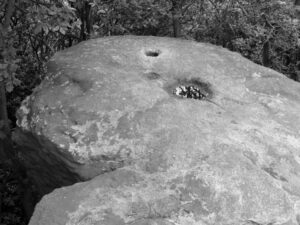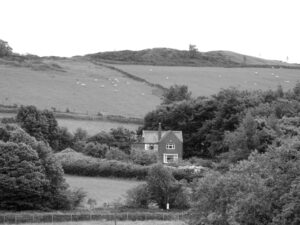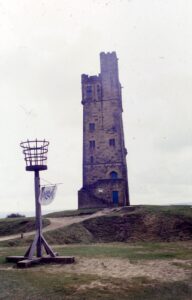Did those feet in ancient time belong to the Devil – or to giants? Kai Roberts calls the question in relation to a Yorkshire legend
Unlike many regions in the S Pennines, including neighbouring districts such as Longdendale, Saddleworth and the Calder Valley, there is a dearth of landscape legends associated with the upland country S of Huddersfield. That situation may not be for want of folklore, but for want of folklorists, especially in that critical period of the 19th Century when the Industrial Revolution began to rapidly erode such anachronistic beliefs. The area never received attention from the likes of Harry Speight or Edmund Bogg, perhaps because they believed that in the heavily industrialised valleys of the Holme and Colne there was already little lore left to save.
What little remembrances we have, we owe to Philip Ahier, especially his masterful compilation Legends and Traditions of Huddersfield and Its District. However, Ahier was operating in the early to mid-20th century, doubtless too late to capture many archaic beliefs. Moreover, Ahier had the spirit of a modern local historian rather than an antiquarian or folklorist. He was more concerned with the traditions of local worthies and their venerable dwelling houses than the superstitions of the lower classes. Hence, a majority of the material he presents is ghost lore attached to crumbling mansions, with genuine landscape legends rare.
Amongst the few examples he does offer, the most famous are those connected with Castle Hill, a topographically prominent summit which can be seen from miles around. Down the ages, it has been the site of an Iron Age hillfort, a Norman motte-and-bailey, a medieval village, Chartist rallies and a folly tower commemorating Queen Victoria’s Jubilee which still crowns the height today. Such a grand elevation has inevitably attracted a number of tales over the years and Ahier recounts several, including secret tunnels, ancient battles and buried treasure.1
Possibly the most developed, however, is a legend that “The Devil, when he first stepped on this earth, hopped from West Nab to Broadstone, on Honley Moor, strode thence to Scar Top at Netherton and jumped to Castle Hill, where he is said to have wandered in the underground passages in its interior”.2 This story crops up frequently in discussions relating to Castle Hill and appears prominently in Kirklees Culture and Leisure Service’s information leaflet about the site.
Ahier goes on to speculate that this tale of His Satanic Majesty’s exploits may have been “a veiled reference to the cruelties perpetrated at the Castle in former days”. He cites a reference from Charles P. Hobkirk’s 1868 History of Huddersfield (itself taken from a manuscript by the prodigious 18th-century antiquarian Roger Dodsworth), which records that “In the year 1307, the castle was strictly examined by a jury and a dungeon discovered, in which the greatest cruelties had been practiced”.3
It is not difficult to see how Ahier reached such a conclusion. The folkloric theory of his day still clung to the doctrine of ‘survivals’, which held that many country traditions extant in the 19th century represented corrupted recollections of the practices of much earlier ages. Today, however, survivalism has long since fallen out of fashion (though not entirely discredited) amongst academic folklorists. Meanwhile, no archaeological excavation on Castle Hill has ever revealed evidence of dungeons; a subterranean discovery causing a brief flurry of excitement in 1969 turned out to be nothing more sinister than a medieval well.4 As a result, Ahier’s hypothesis now looks somewhat fanciful.
Indeed, it seems that in perceiving the legend as a personification of Castle Hill’s troubled history, Ahier may have been focusing on the wrong projection of the landscape. It is not where the Devil landed that is significant, but the place from which he jumped. This spot is supposed to have been Scar Top at Netherton; Ahier describes it as “a remarkable projecting ledge of rock standing some 6ft above the sloping ground. From its top a very fine view of the Mag Valley extending to Meltham can be seen. On its somewhat flat surface is an imprint of a footprint, which, so tradition relates, is the mark of the Devil’s foot as he leapt to Castle Hill”.5
 The Devil’s Footprint (Kai Roberts)
The Devil’s Footprint (Kai Roberts)
Supposed ‘footprint’ stones have a clear folkloric pedigree as sites of geomantic interest. The exact significance of such rock features to earlier generations remains an enigma, but veteran earth mysterian Janet Bord has amply demonstrated that they proliferate across the country. There are several more in the S Pennines alone, such as Great Rock in the upper Calder Valley6 and above Sabden in the Forest of Pendle.7 These marks are similarly attributed to the Devil, but there is reason to believe that in such stories Old Nick has only recently been transposed onto an older motif, and the evidence of the stone at Netherton may confirm this.
Although thanks to Ahier the story of the Devil leaping from Scar Top may be better known, there is an alternative version of the tale. It appeared in the Holme Valley Express in 1987 in an article discussing plans to create a picnic site at Wolfstones Height, a popular beauty spot located between the villages of Upperthong and Netherthong. The proposition provoked the ire of Holmfirth Civic Society member Eric Hadfield, who poetically argued that the ‘Child o’ th’ Edge’ should not be disturbed, referring to a local legend associated with Wolfstones Height, which forms the simulacrum of a recumbent child.
 Wolfstones Height (Kai Roberts)
Wolfstones Height (Kai Roberts)
Hadfield went on to relate the full narrative: “I hope that the sleeping Child o’ th’ Edge will be allowed to remain at rest, as was the decision of her father. He was a giant who lived in Magdale with his tribe. And when it was reported to him that his child was lost, he hastened up to the rocks at the end of Springwood nearby in Netherton for a good viewpoint. He had been told that she had been seen at Wolfstones Height. So he made a mighty springing jump from these rocks – evidence is shown from the deep footprint – and found her there, asleep on her back. In fact, she was dead, so he let her rest”.8
It is clear that the giant’s footprint to which Hadfield refers is the same as the Devil’s Footprint recorded by Ahier. Hadfield goes on to justify the antiquity of the legend by drawing attention to the name of Cocking Steps Mill on Lea Lane, immediately below Scar Top and Springwood. He explains that the footprint stone was originally known as the Cocking Step, an archaic dialect term for a run and a jump. Indeed, the phrase still survives in fencing jargon to describe a thrust accompanied by a leap forward.
The name of Cocking Steps Mill suggests that whilst the legend of the Magdale giant was not recorded in print until many years after Ahier’s version, it may actually predate it. The mill was founded by James Wrigley who died in 1809,9 suggesting that the story was already well-known in the late 18th century. Equally, Hadfield told the Holme Valley Express that the legend “was passed down to me by word by my father who was a native of the Holme Valley”,10 suggesting that it may have been preserved as an oral tradition in the area for a number of generations.
It is also true that landscape legends involving giants tend to predate those involving the Devil. Folklorist Jeremy Harte observes “The origin legends that now go under the Devil’s name are all recorded in other sources with giants as the protagonist. In the earliest accounts, it is they who dig the ditches, hurl the stones and leap from crag to crag to leave their footprints impressed into the solid rock… A preference for the Devil as protagonist is a new and typically English development of the Nineteenth Century… The mythical element is a storyteller’s gloss on the observed facts and the Devil appears in these stories only as a late substitution for the fairies, giants and heroes who had previously been the protagonist”.11
It is, of course, impossible to establish the exact provenance of the tale of the Child o’ th’ Edge. The folklorists of a previous generation may perhaps have suggested that the giants were corrupted remembrances of pre-Christian deities worshipped in the district and animistically perceived in the surrounding landscape. This is not an entirely absurd suggestion; there are plenty of topographical features in Scotland, for instance, still attributed to ancient gods with gigantic attributes, especially the elemental Goddess figure, the Cailleach.
Weighted against this is a modern incredulity that any oral tradition could have survived over so many centuries, even in a corrupted form. Meanwhile, giant legends have been a consistent staple of English folklore in many ages, enjoying periodic revivals in popularity. Such figures were especially prominent from the late Middle Ages until the English Civil when their effigies were paraded during Midsummer civic festivities (such as Gog and Magog in the Lord Mayor’s Pageants in London)12 and carved on chalk hillsides (both the Cerne Abbas giant and the Long Man of Wilmington are believed to date from this period).13
However, we might tentatively agree with Harte that the attribution of the footprint stone at Netherton to the Devil is no older than the 19th century. In addition to the evidence of similar cases across the country,14 Ahier records a very telling detail about the Scar Top footprint stone. He writes, “This spot was most notorious in early 19th century days; on Sundays, it was the scene of gambling schools playing pitch and toss; on winter week-nights, it was the rendezvous of unruly youths ever ready to pass rude remarks to casual pedestrians”.15
In addition to reminding us that juvenile delinquency is scarcely a modern phenomenon, this historical note suggests a compelling reason why the stone may have become connected with the Devil. It has been observed that landscapes ascribed to the Devil in England are usually unproductive tracts of land (such as ditches and ravines) or eerie places which locals might avoid passing at night.16 To this, it seems perfectly reasonable to add sites where anti-social or taboo behaviour was common. For the God-fearing folk of the Holme Valley (in common with much of the S Pennines, Methodism flourished in the area during the 19th century), associating the dissolute influence of Scar Top with the Devil, even if only symbolically, would be natural.
This also makes sense when considering that, historically, footprint stones were sometimes attributed with the power to impart a degree of their maker’s character to any person who stood upon them. For instance, in 1598 the poet Edmund Spenser recorded an Irish custom whereby “They used to place him that shall be their Captain upon a stone always reserved for that purpose and placed commonly upon a hill: in many of which I have seen the foot of a man formed and graven, which they say was the measure of their first Captain’s foot, whereon he standing receiveth an oath to preserve all the former ancient customs of the county”.17
Of course, even if we conclude that the attribution of the footprint to a giant antecedes its attribution to the Devil, this does not mean the latter is somehow an ‘inauthentic’ revision of the legend. Perhaps the largely discredited ‘survivals’ model of folkloristics would perceive it as such. From such a perspective, the substitution of a giant by the Devil might seem like an artificial Christian gloss attempting to disguise an older, more native pagan motif. However, a more enlightened view would recognise that folklore is not a static entity preserved in aspic for countless generations, but a dynamic process which responds to and reflects the ever-changing beliefs of a population, a process which the shifting narrative of the Scar Top footprint stone ably demonstrates.
Indeed, the two variations on the footprint theme should not be seen as competing. Rather, they broaden the diversity of landscape lore in this neglected area of the South Pennines, creating a psychogeographical nexus which links the node of Scar Top to two other topographically significant locations. Whilst the legends associated with Castle Hill are many and well-known, the personification of Wolfstones Height as the Child o’ th’ Edge is an overlooked and distinctly poetic addition to the canon of folklore in the Huddersfield district. Hopefully this discussion will have gone some way to bringing it to wider attention.
 The Victorian Jubilee Tower at Castle Hill, Almondbury
The Victorian Jubilee Tower at Castle Hill, Almondbury
Notes
- Philip Ahier, Legends and Traditions of Huddersfield and Its District Vol. 1 1944:231-6
- Ahier1944:15
- Charles P. Hobkirk, Huddersfield: Its History and Natural History 1868:122
- ‘Old ghosts may be excused their groans’, Huddersfield Daily Examiner, 22-7-1969, p4
- Ahier 1944:15
- John Billingsley, Folk Tales from Calderdale Vol.1, 2007:39-43
- Janet Bord, Footprints In Stone 2004:113
- ‘Picnic area plans for prominent Height brings legendary site warning’, Holme Valley Express 18-12-1987, p12
- Douglas N. Dearnley, The History of Netherton and South Crosland 1985:44-5
- ‘Picnic area plans for prominent Height brings legendary site warning’, op cit
- Jeremy Harte, ‘The Devil’s Chapels: Fiends, Fear and Folklore at Prehistoric Sites’, in Joanne Parker (Ed.), Written On Stone: The Cultural Reception of British Prehistoric Monuments 2009:28-32
- Jennifer Westwood & Jacqueline Simpson, The Lore of the Land 2005:469
- Jacqueline Simpson & Steve Roud, A Dictionary of English Folklore 2000:52, 392
- Jeremy Harte, ‘The Devil’s Chapels’ op cit, p28
- Ahier 1944:15
- Simpson & Roud 2000:94-95
- Quoted in Charles R. Beard, Luck & Talismans: A Chapter of Popular Superstition 1934:151
Published in NE135 (Autumn 2013), pp.8-11